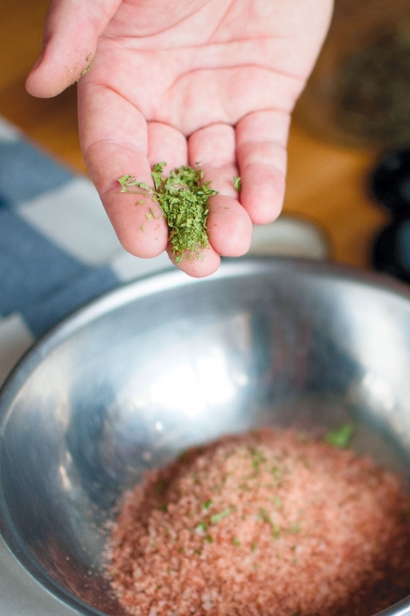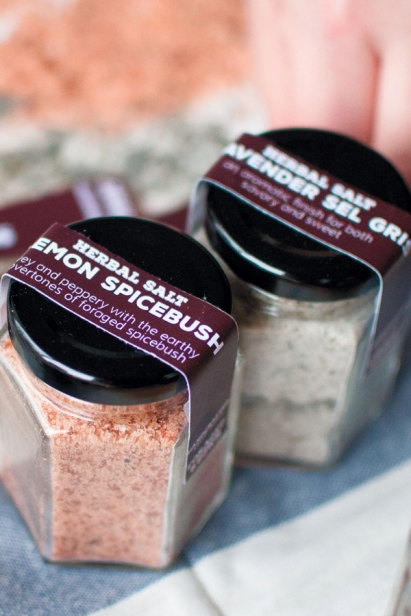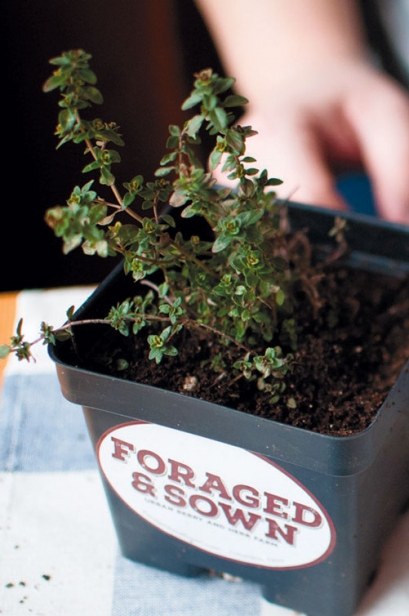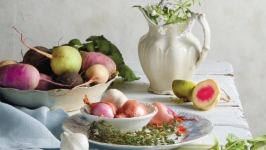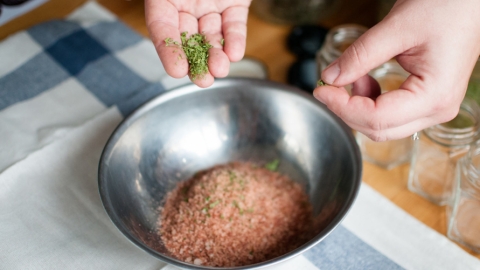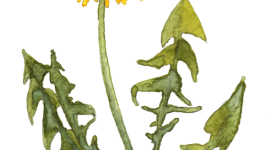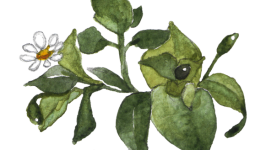Dig In: Foraged & Sown Celebrates Local Flavors from the Backyard to the Forest
Kate Hodges forages for flavor. And for fun. And, of course, for food. But it’s the quest for flavor that’s the real driving force behind her business, Foraged & Sown, which launched just over a year ago.
Kate calls herself a forager and market gardener. She tends to a modest plot of land in her North Linden backyard, supplemented by bits of land that neighbors let her cultivate, hosting berries and rhubarb. Beyond that, she scours acres of private property owned by friends outside Columbus city limits, foraging for seasonal plants, herbs and berries on land she calls “a culinary dream of woods.” All told, Kate combs a multitude of sources for fresh ingredients—some intentionally planted, others more chance—but all in tune with the seasons and the soil.
Combined harvests are processed and packaged for sale at the Clintonville Farmers Market where, come spring, Kate offers culinary herbs, berries, salts, seedlings and more. Foraged & Sown emerged as a way for Kate to legitimize hobbies that come naturally to her—gardening, cooking and foraging. “It’s something that I love to do and something that I would be doing anyway,” Kate says.
“I grew up gardening with my parents and my sisters and sometimes we lived in the country so it was a big garden with a lot of space to play around in,” Kate says. “So I grew up doing things like eating a lot of tomatoes right off the vine, picking weeds in the yard and tasting them. The memory is there because of the flavor. So what I can draw back on is always flavor and scent, which is how everybody’s memories are tied.”
Foraged & Sown provides a source for unique or highly seasonal ingredients, like ramps, a perennial favorite. “The beginning of market season is ramp season and I could not bring enough ramps,” Kate says. “They’re usually only at market the first three weeks, and that’s pushing it a little bit because ramps actually start before the market even opens.”
Ramp season transitions to seedlings, which are popular as market patrons plan their spring gardens. Kate sells berries she grows, like strawberries and currants, and those she forages, like service berries and mulberries. There are nettles, which begin in spring and last throughout summer, and spicebush, of which the leaves and berries can be consumed. Last fall, Kate even processed her own acorn flour, which she baked into cookies that proved popular at market.
Nothing goes to waste within Foraged & Sown.
“I dry and reuse the stuff that doesn’t sell at market,” Kate says. “So the spicebush berry—I’m not going to bring it back the following week, so I’ll just dry it and then I put it into salt blends. The spicebush leaves, if they don’t sell, I dry them and package them in tea bags,” she adds. “I try to have very little waste.”
She applies the same mentality when foraging, where there’s a delicate balance between what’s abundant and what’s necessary to take.
“I think it’s important to not get excited about something that can be foraged a whole bunch and then let it go to waste. Just like you wouldn’t buy 16 heads of broccoli at the grocery store and then let 14 of them spoil. It’s the same thing,” Kate says.
Foraging, like gardening, is a skill that can be honed with practice and patience. But it’s an easy journey to begin—as easy as looking closely in your own backyard, says Kate.
“I think anything that gets you looking at plant leaves is a good starting point. So looking at the lawn even, in front of your house, if you’ve never looked at it. It’s fun!” she adds. “If you look at it you’ll probably notice in addition to the grass, there’s going to be a ton of other things, too.”
Kate recommends foraging around water sources, like creeks, especially on south-facing slopes where plants soak up early sunlight. Better still if in a deciduous forest, which has fertile soil from leaf litter.
Be sure to take note of local laws: “It’s not legal to sell commercially things that are foraged from public land,” says Kate. Foraged items from personal property or private land used with permission are okay.
Kate takes part in the occasional collaboration or class, and is open to leading groups on foraging lessons. She recommends foraging with kids since, “it’s active and they’re able to pick up on it really quickly.” Don’t be dissuaded by fears of poisonous plants, either.
“There’s a huge misconception about how many poisonous plants there are out there,” Kate says. “It’s not a lot.”
“If you have good book guides you’ll be fine. The book will tell you if there’s something that looks like it,” she adds.
Every Saturday during market season, on a sunny stretch of sidewalk in Clintonville, Kate reaps another benefit as proprietor of Foraged & Sown: She gets to connect with market patrons, connecting with the flavors.
“For me,” she says “foraging and growing is all about seeking different flavors, which is why I really lean toward the culinary herbs and the berries, because you can taste five different varieties of raspberries and they all taste different. You can grow three different types of sage and they’re going to be different,” says Kate, who is, incidentally, speaking between sips of a sage-infused latte.
While Kate sells almost exclusively at the farmers market, she sources for a few, small wholesale accounts in town like Chef Kevin Caskey of Skillet.
“[Kate] has been able to source for us items that are generally not available to us or just traditionally not farmed as a commodity. Even more important, the sourcing is at a hyper-local level from the wild or sometimes even an urban setting. Wild nettles come to mind, dandelion greens, lamb’s quarters; once she was even able to score a huge find of local mulberries! As a chef, I think about each ingredient’s provenance and what it brings to the plate, and I can trust that what Kate brings to us has been passed through a minimal number of hands,” he says.
Kate’s pursuit of flavor benefits a community that can learn to taste, and love, what’s available to us—in our backyards, our gardens and our forests.
“I really get jazzed when people taste something new just so they have the experience. I don’t care if you like it or you don’t,” she says, smiling.
“I think that’s the most important thing—digging into what there is.”
Foraged & Sown, foragedandsown@gmail.com
A Forager’s Field Guide
Kate Hodges of Foraged & Sown recommends the following resources for aspiring foragers:
The Peterson Field Guide to Wild Edible Plants
Edible Wild Plants by Thomas Elias & Peter Dykeman
Everything by Samuel Thayer. “Fantastic and go really into depth, like if you want to look up how to process acorns, it probably has 50 pages on it.” Also provides historical context.
Kate says, “I am going specifically from the foraged ingredient to a culinary use, so things that have recipes are important to look at for me and my favorite one is called Foraged Flavor by Tama Matsuoka Wong. She collaborated with Chef Eddy Leroux at Daniel. The recipes are fantastic, I mean really good.” (Kate actually keeps two copies around she loves it so much.)



